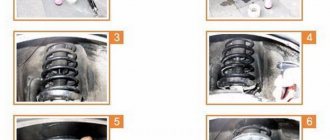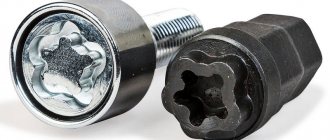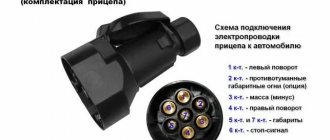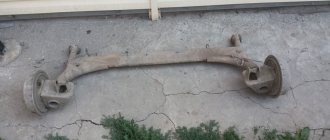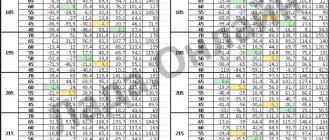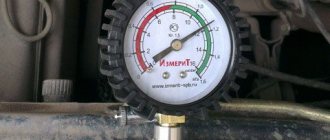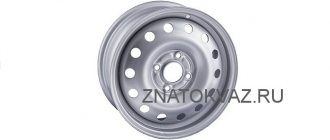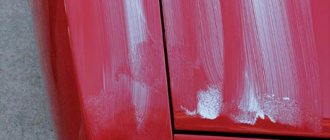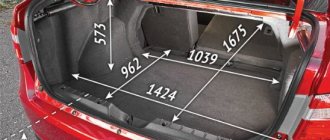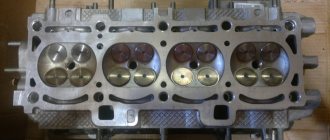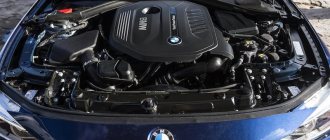A garage with an inspection pit is valued much more among car enthusiasts than an ordinary car box. Suspension repair, oil change, muffler, brake pads, etc. It is much more convenient to carry out work under the bottom of the car while standing at full height than lying on the ground. A do-it-yourself inspection hole in the garage is an opportunity to save on the services of professional craftsmen and better study your car in comfortable conditions.
Garage floor removal and excavation work
First, it is necessary to clear the garage space of foreign objects so as not to interfere with the construction process.
A section of the floor is marked according to predetermined dimensions, pegs are driven into the corners of the future pit and the string is stretched. When digging a pit, the soil is carried outside. The clay should not be removed too far. It will be useful for sealing the walls. After reaching the required level in depth, the walls are trimmed until the profile is completely straight and vertical.
The bottom is carefully leveled, and a cushion is poured from layers of crushed stone (up to ten centimeters) and sand (five centimeters). The sand is compacted until maximum density is achieved, with the addition of water. Then a waterproofing film is laid.
Basic construction technology
After the hole is dug, you need to properly level the walls and bottom with shovels. After this, the floor is installed first. First, the bottom is covered with sand in a layer approximately equal to 20 cm. The sand is compacted well, watering it with water if necessary.
Crushed stone is laid on top of the compacted sand bed. Its layer should not be less than 10 centimeters. Crushed stone is also compacted well. On top of the crushed stone, rods of metal or plastic reinforcement (6-8 mm) are laid and tied with wire along and across the pit, forming squares with a side of approximately 150 mm.
Construction lattice can also be used for reinforcement. The final stage is to fill the bottom of the pit with concrete. The layer thickness must be at least 80 mm.
How to make a viewing hole: step-by-step instructions
To equip an inspection pit in a garage, it is not necessary to have a builder’s diploma. Just follow the step-by-step instructions.
Marking and forming a pit
The first thing to do is mark and dig a pit.
For this purpose:
- measure the width and length of the pit according to the established dimensions;
- drive stakes into all 4 corners and pull the fishing line;
- dig a pit strictly according to the marked markings;
- level the walls;
- fill the bottom with 2 layers of crushed stone of any fraction (height 5 cm), compacting it each time;
- covered with a layer of construction sand (5 cm) and also compacted.
Waterproofing
To protect the inspection pit from groundwater, waterproofing is necessary. It comes in 2 types:
Outdoor
During its implementation, the pit is covered with waterproof material. Each subsequent layer should cover the previous one by no less than 15 cm. The edges of the film extend 20–25 cm onto the garage floor. For greater strength, the joints are glued with double-sided tape.
External insulation is done exclusively during the construction of the pit. Some people neglect it, citing the deep occurrence of groundwater, that is, the minimal risk of it entering the pit. However, the possibility of its increase always exists. For this reason, it is better not to neglect this type of protection such as external waterproofing.
Internal
This type of waterproofing involves treating the walls and bottom of the pit with special compounds that reduce the hygroscopicity of the building material. Ideally, choose a special composition designed for treating swimming pools. It looks more attractive and provides better protection.
Another way to prevent excess moisture from getting into the pit is to equip a caisson, which is a metal box that is installed in the pit itself. To prevent the device from being squeezed out by water, metal rods about 1 m long are welded to its sides and driven into the ground.
When groundwater seeps into a pit after its construction, you can get rid of it using the so-called pit - made in one place of the pit and a recess secured with concrete. This will make it possible to collect moisture in one place and make it easier to work in the pit itself.
Interior finishing of the pit
Since the car has to be repaired even in the cool season, it is recommended to insulate the inspection hole. For this purpose, extruded polystyrene foam is often used, which is laid on the walls and floor between the waterproofing coating and the internal lining.
A reinforcing mesh is placed on the insulation and the floor is filled with concrete (5 cm). You can make concrete with your own hands by combining 1 hour of M 400 cement, 3 hours of sand and 5 hours of crushed stone.
After the concrete has hardened (1–2 weeks), the walls are laid out. For this it is recommended to use:
- brick (preferably moisture-resistant ceramic). A do-it-yourself inspection hole in a garage is usually made of brick, half a brick;
- building blocks;
- reinforced concrete (grade M 250). For reinforcement, a special reinforcing mesh or reinforcement is used. The thickness of the concrete wall is about 20 cm.
If facing walls with bricks or building blocks is not particularly difficult, then pouring walls with concrete will require more tinkering. Before pouring them, you need to make wooden formwork.
After laying out the walls, install a metal fence around the entrance to the pit, which should rise approximately 20 cm above the level of the garage floor.
Bottom design
The bottom of the inspection hole can be earthen or poured concrete. In turn, concrete is covered with tiles, rubber or wood (boards, ladders).
Project development and site marking
The work should begin with the development of the project. To do this, a ready-made site plan is created or used, indicating the location of all objects, as well as plantings. At this stage, all materials are selected, since this moment is reflected in the project. As an example, when choosing a brick, the width of the masonry is 12 cm.
When creating a project, the following information is taken into account:
- Soil freezing depth.
- Groundwater level.
- Soil type.
The project must contain the following information:
- Drawings showing the layout of the structure.
- Site drawings.
- Diagrams of the main structural elements, for example, fastening the rafters.
- An explanatory note indicating the type of materials selected and other points.
- Information about how much and what material will be required to complete installation work.
If you wish, you can download the project from the Internet or order its development from a specialized company. As for the features of the inspection pit, its dimensions, the type of material used for insulation and finishing, the method of supplying communications and other points are indicated. It is worth remembering that only with a well-prepared project can you expect that the structure will have high performance qualities.
Waterproofing
There are several ways to waterproof an inspection hole in a garage. Each of them has certain advantages. For example, external waterproofing of an inspection pit is created only at the construction stage. The internal one can be mounted after creating a full inspection hole. Before work, it is better to create a full-fledged drawing, which will indicate all the materials from which the structure is made.
Protection of the inspection pit from the outside
If at the site where the garage is being built, the soil waters lie very deep, for example, below 2.5 m, waterproofing the inspection pit may not be necessary.
It is important to check the soil water level in the spring. If even during a flood it does not rise above the specified indicator, you don’t have to worry about waterproofing
However, the geological situation may change. In a dry place, water can easily appear after a few years. If there is already an inspection hole, it should be equipped from the inside. For this purpose, special impregnations are used. They penetrate deeply into the structure of the stone and perfectly protect the inspection hole from water penetration.
A variety of films are used for external waterproofing of inspection pits. The pit is covered with such products from one ridge to another. In this case, it is necessary to release 15 cm on each side. The panels must be laid overlapping. The joints are connected with double-sided tape. The film should adhere well to the walls. To do this, it needs to be straightened. During installation work, you need to carefully monitor the integrity of the film.
Internal waterproofing of inspection pit
A special impregnation is used as internal waterproofing of the inspection pit. This type of waterproofing is called coating. The inspection hole in the garage can be coated with a special composition for swimming pools. When using such material, a waterproof film appears on the surface of the walls, which in external parameters and characteristics resembles rubber. It is usually painted blue and is easy to clean once it hardens. When using this composition, treatment should be carried out at least 2 times.
Another option for protecting the inspection pit from water is to use a cement-based primer. It contains polymer particles that can reliably block small channels that allow moisture to pass through. When performing one of these measures, the hygroscopicity of the walls is significantly reduced. If water constantly appears in the pit, the treatment should be carried out 2 times.
Installation of a caisson in an inspection hole
To ensure that the inspection hole in the garage is reliably protected from moisture, you can make a caisson. To do this, a box is welded from metal sheets and installed in a pit. It must be treated with anti-corrosion agents. If the welds are made airtight, water will not penetrate into the pit. If there is too much water, the caisson may “float”.
To eliminate this situation, corners should be welded to the caisson, extending 1.5 m into the ground. In order not to carry out large-scale excavation work, before installing the caisson, you should hammer the corners into the ground and leave their ends outside. They are welded to the caisson after it is placed in the pit. In this case, the pit will have to be made in a large size. The advantage of this solution is that the corners will be driven into denser soil and the caisson will be held better.
There is another way to avoid raising the caisson in the inspection hole under the influence of groundwater. At a certain height it is necessary to make a hole. Through it, water will flow into the caisson as it rises. It is subsequently pumped out. Such an inspection hole can last for more than 20 years until the metal rusts.
Pit for catchment in inspection hole
If there is already a finished hole, water can still penetrate into it. Sometimes coating waterproofing does not help from this. In this case, you will have to build a drainage system. It can be located around the entire garage. You can also make a special hole in which excess moisture will collect. A pit is made in the corner of the pit. The accumulated water is subsequently pumped out of the pit with a pump. The system can work automatically. To do this, install a water level sensor in the pit.
Formwork should be made under the pit, and then concrete should be poured into it. After this, it is necessary to waterproof the pit. It is usually carried out together with waterproofing work carried out throughout the inspection pit.
With such waterproofing, it is impossible to completely get rid of dampness, so boards are laid on the floor. They can be protected from rotting using special treatment. You can buy a special impregnation for wood that comes into contact with the ground.
Arrangement
For the normal arrangement of the inspection pit, several conditions must be met. To create normal conditions, ensure the integrity of building structures and prevent freezing, waterproofing is performed. For convenience of work, a stationary lighting should be installed in the pit.
The staircase is made by masonry, metal elements or wood. The choice of materials depends on the capabilities and preferences of the owner. But the structure must be securely fastened.
Waterproofing
Waterproofing is achieved by laying polymer film or roofing felt in a dug and prepared pit. If groundwater lies much further than the maximum depth of the hole, waterproofing is not necessary, but it is better to play it safe and fulfill this condition to ensure dryness inside.
If it is not possible to completely isolate the pit from water, a pit and a drainage system are made on one side to remove the accumulated water into the sewer system. If this problem exists, to ensure maximum ease of use of the drainage, install sensors and a pump that automatically turns on when a certain water level in the pit is reached. An alternative, but expensive option is to make a caisson from an all-metal welded box according to the dimensions of the pit.
Normalization of the humidity level is achieved by a ventilation device; for this purpose, nylon sewer pipes are used, previously laid from the bottom of the wall with outlet from the room to the outside.
Insulation
Insulation is carried out using roofing felt and polystyrene foam boards. Ruberoid is laid overlapping on the walls and floor, then the structures are covered with insulation boards, fixed with special glue. As a result, freezing of elements and accumulation of condensation in winter is prevented.
Backlight
To provide lighting, when cladding walls, electrical wiring is laid, then lighting lamps are installed. To ensure safety, lighting elements are made with closed shades and protection from mechanical damage.
What state standards and regulations exist for inspection pits?
Regulatory documents regarding the equipment of the inspection pit apply exclusively to enterprises involved in the inspection of automotive equipment. They assume that this structure is part of the technical base, and therefore is subject to appropriate registration, in full compliance with existing GOSTs.
There are only a few such documents. The regulations are more concerned with the rules regarding lighting and ventilation schemes, safety, rather than dimensions. If the structure is not equipped for the purpose of conducting commercial activities, compliance with the requirements of these documents is not required. Otherwise, it is necessary to study the relevant regulatory framework.
The absence of the need to register a garage with an inspection pit does not mean that it can be erected in any order. There are certain standards on which the safety and ease of operation of the structure depends. An important factor is deciding which vehicles are supposed to be serviced - cars and/or trucks. This determines the dimensions of the future structure.
Requirements
For the construction of pits for car repairs, their own standards have been developed, but they apply only to enterprises that inspect and maintain automotive equipment. The technical base must be registered, so it is assumed that it complies with current GOSTs.
The inspection hole must provide:
- safety - both for humans, cars and other building structures;
- convenience when working - you can stand up to your full height inside;
- Easy maintenance - repairs and cleaning are not difficult.
The structure must be protected from groundwater and flooding when washing the car. When the pit is not in use, it should be covered with a covering or lid on top to prevent anyone from falling into it.
In private development, no one checks the standards, so every garage owner is free to resolve this issue as he or she wishes. But this does not mean that reasonable requirements for the convenience and safety of operating the pit should be violated. Safety precautions must be followed.
Peculiarities
If you have a small plot of land next to your house, you can do a lot of interesting things with it. The main thing is to make full use of every free square meter. In a small area, you can create with your own hands a place where you will have a pleasant time both alone and in a noisy company of friends. Even a small square of land can be arranged in such a way that there will be something to do on it for both small children and experienced gardeners.
True, before you start designing a summer cottage, you need to take into account all its features. If you have never gardened and know nothing about working with the soil, then it is best to immediately seek help from professionals.
Do-it-yourself inspection hole on the street for a car. Construction stages
In order to understand how to make an inspection hole on the street, not to get into trouble and not to alter or complete the finished structure, it is worth carefully considering all the requirements that an inspection hole on the street for a car must meet.
Size calculation
For convenient work, the length of the inspection hole should not be less than two meters. To this size it is necessary to add the dimensions of the structure for descent - a staircase with steps or a welded stepladder.
The depth of the pit is selected in accordance with the height of the person who will use it, plus 20 cm to the top of the pit. To this size, 10 cm is added for filling the floor with crushed stone and pouring concrete. If it is assumed that people of different heights will use the inspection pit, the depth should be designed for the tallest person. It is better to place a special stand under your feet than to work bent over.
The width of the trench for constructing an inspection hole is selected depending on the distance between the wheels of the vehicle being serviced (30 - 40 cm less). To this size it is necessary to add the double thickness of the walls of the pit itself.
Operating procedure
When making an inspection hole with your own hands on the street, it is very important to thoroughly carry out all the construction stages provided for by the technology. In a pit dug in accordance with the selected dimensions, a layer of crushed stone is placed on the floor and thoroughly compacted using a tamper
In a pit dug in accordance with the selected dimensions, a layer of crushed stone is placed on the floor and thoroughly compacted using a tamper.
The presence of water will not allow you to comfortably use the inspection hole, so it is very important to make reliable waterproofing. It can be made from several layers of polyethylene or bitumen-based materials, insulating the floor and walls from the possibility of moisture penetration
The installation of waterproofing sheets is done so that at the joints they overlap each other by an arc of 15 - 20 cm and the edges extend out of the pit onto the ground by at least 25 - 50 cm.
The next stage, with a thickness of 7 - 10 cm, using a reinforcing mesh, is poured into the floor with concrete mortar and after the mortar has hardened, the walls are erected.
On dry soils, bricks can be used for walls, but if groundwater is close, then only monolithic reinforced concrete is used.
When laying the walls of the pit, it would be useful to arrange small niches in them for tools, fasteners or spare parts.
When the required height of the pit walls is reached (slightly above the ground level), a frame welded from a metal angle (with the corner inward) is attached on top of them to lay boards that protect against accidental falling into the pit when it is not in use. For this, boards with a thickness of at least 50mm are suitable. The wood must be treated with any composition that protects against rotting and fungus or painted over with waste oil.
A concrete blind area is poured around the finished inspection pit. In addition, the best solution is to install a canopy over the pit to protect it from precipitation. If this is not possible, then an additional waterproof cover is required, at least 50 cm longer and wider in size than the constructed inspection hole on the street.
Difficulties you may encounter
The car owner needs to take into account the following problems that sometimes accompany the installation of an inspection hole:
- shallow groundwater - you will need to carry out thorough waterproofing, and if the problem cannot be completely eliminated, arrange a pit and drainage for accumulating moisture;
- insufficient area of the room where the pit is installed - in this case, construction should be carried out in another place. In no case should the excavation damage the foundation of existing structures;
- inadequate quality of materials – when purchasing cement and other compounds, you should contact trusted retail outlets, since if the quality is insufficient, the work will be significantly delayed and will result in cost overruns.
The work must be pre-organized, the required volume of materials must be calculated, and tools and equipment must be prepared. Construction should be completed as quickly as possible to meet the appropriate temperature conditions of the season and ensure the quality of the work.
An inspection pit is a necessary element of any car enthusiast’s garage, but during its construction it is necessary to ensure that all requirements are met in terms of the selection of materials and project development.
This will ensure ease of maintenance and repair of the vehicle, while complying with safety requirements.
Purpose and features of the inspection pit
To close the inspection hole, it is necessary to make a hatch from durable materials
The design makes the room more functional and saves time and money. The owner will not need to travel to the service center frequently: it is more convenient to carry out repair operations in a garage equipped with a pit. In addition, it can be used as a warehouse.
The pit can be equipped at the initial stages of building a garage or in an already used room. If possible, it is better to provide for it at the design stage before the start of construction. In this case, labor and time costs will be less and there will be no interference during soil removal
In this case, it is also important to take care in advance of the drainage system, which includes pipes connected to the collector. This will help remove excess moisture in a timely manner and reduce the concentration of vapors in the air, which helps to increase the service life of the garage
If the pit is organized in an already used garage, labor costs will be higher. But this option also has an advantage: the construction site is closed. The roof protects the pit from being washed out by rain. The floor in the room, as a rule, is a thick reinforced screed. When arranging a pit in this case, markings are created and then the concrete is crushed. Reinforcement tails are cut around the perimeter. Soil and a cushion of sand and gravel are removed from the resulting pit. For this operation, ordinary shovels are used. To make the process go faster, it is worth inviting an assistant. The bottom and walls of the pit need to be leveled as much as possible.
What is it for?
An inspection hole is constructed in a garage or other room where the car is kept, or in a specialized room intended for its repair and maintenance. It is possible to construct a pit outdoors if, for some reason, it is not possible to do it indoors.
This way provides unobstructed and convenient access to components and parts located underneath the machine. This allows you to replace elements, lubricate, adjust, tighten mechanisms and other necessary operations.
Standard sizes
There are no standard sizes that this design must comply with. Dimensions are selected based on the size of the machine and are:
the minimum width of free space is at least eight hundred millimeters
It is important to correctly calculate the distance and width of the ditch when laying the hole. The final width dimensions should be two hundred millimeters less than the vehicle track size (if we take the distance between the internal planes of the running wheels)
The width of the ditch is made three hundred millimeters larger than the final dimensions to ensure strengthening of the walls; the length is determined by the dimensions of the room where the work is performed and must exceed the corresponding dimensions of the machine by at least five hundred millimeters in each direction. Taking into account the above circumstances, this size ranges from two to six meters. It is also necessary to take into account the construction of a ladder for descending into the pit. It is performed in an attached or stepped version. The attached option will save space, but is less safe and convenient; the depth parameter depends on the height of the car owner. Initially, the pit is dug up to two meters, so that the finished height is about eighty meters or a little more. When choosing the depth, it is necessary to start from the level of groundwater.
The optimal dimensions are determined by the characteristics of the room where the pit is installed, the height of the owner of the car and the size of the car. It is also necessary to foresee the location of the stairs in advance. The optimal solution is to place it at the back. But sometimes the size of the garage does not allow this, so the optimal solution is to locate the entrance on the side. Before starting construction, it is necessary to complete a drawing showing the actual dimensions of the room and pit.
Passenger car
For passenger cars, the pit dimensions will be slightly smaller, since this is determined by the dimensions of the vehicle. Also, less attention may be paid to strengthening the walls. The main dimensional parameters were discussed above.
Freight
The pit for trucks is made longer, but if work is expected to be done on it for both trucks and cars, the width is adjusted to the track of the car.
Considering the large weight of the truck and the increasing load on the floor, this must be taken into account when strengthening the walls.
Strengthening the pit
The walls must be properly reinforced. To do this, lay half or a quarter brick. This depends on the type of equipment being serviced in the pit. For freight transport, the thickness remains greater to ensure structural integrity under significant loads.
An alternative and less expensive, but more labor-intensive way is to concrete the walls. To do this, a frame is mounted from angle and reinforcing bars, and formwork is installed. The upper edges of the formwork are secured with spacers. Then the space inside the formwork is filled with concrete. It is necessary to ensure proper quality of the concrete mixture and complete filling of the formwork, without the formation of voids.
To prepare one cubic meter of concrete solution you will need:
- six fifty kilogram bags of cement;
- seven hundred kilograms of sand;
- two hundred liters of water;
- one thousand two hundred kilograms of crushed stone.
The solution is thoroughly mixed by hand or using a concrete mixer. Hand kneading will require more water.
The top is covered with a cement screed and a steel corner edging. If after pouring concrete there is a gap between the walls and the ground, it is compacted using clay left over from digging a pit.
Preparation
First of all, you will need to carry out comprehensive preparatory work. Now we will highlight all the most important points.
Groundwater
One risk factor is of great importance - the level of groundwater rise. The final success of the construction of the inspection pit largely depends on this. In some cases, it is necessary to abandon the construction of such a pit or cellar. You need to be prepared in advance for the fact that the water level will be critical.
Unfortunately, in some settlements there are no specialized geological services at all, where appropriate surveys are carried out. But you can independently determine the level of groundwater rise with fairly high accuracy. This is done as follows. You need to dig a hole 2.5 meters deep. Watch to what level the water rises. When the worst forecasts are confirmed, that is, the waters lie too close to ground level, it is better to abandon the construction of a viewing hole. Of course, purely theoretically, it is possible to ensure waterproofing even in such a situation, but then the pit will resemble more of a bunker, great effort and investment in construction will be required, and the danger of flooding will still remain.
Another option that will help cope with the natural risk factor is to arrange drainage. It happens that a car enthusiast works on his car professionally, he needs an inspection hole, but there is no opportunity to choose another area. In this case, high-quality drainage of groundwater should be done. A special drainage well is dug outside the garage, where the water is drained. But such work is labor-intensive and requires significant investments.
We correctly determine the dimensions of the inspection hole
It is very important to immediately accurately determine the optimal parameters of the inspection hole. It shouldn’t be too big, but it’s also inconvenient to work in tight spaces.
Everything must be selected correctly, of course, in accordance with the dimensions of the car.
Let us dwell on the methods for determining key parameters.
- Pit length. Consider the vehicle parameters. Typically, the standard length of an inspection pit for a passenger car is approximately 4-5 meters. To arrange a convenient descent with an extension or monolithic ladder, you need to add another meter. These are good parameters that are aimed at comfortable, rational use of the inspection pit. You will no longer need to regularly move the car during repair work, as happens if the hole is too small or short.
- Width. Here the distance between the wheels of the car plays a key role for you. The standard parameter for modern passenger cars is a pit with a width of 75-80 cm. This width will be quite sufficient, and it will not be too large.
- Depth. Everything here is strictly individual. Of course, they work standing in the inspection pit. Some dig shallow holes so as not to provoke pressure and flow of groundwater, but it is inconvenient to work while sitting on a stool. It is better to make a good deep inspection hole. Approximately 15 cm is added to the height of the car enthusiast. When any doubts arise about the depth (for example, when several people of different heights are planned to work in the pit), of course, it is better to make it larger. After all, if necessary, you can simply make a small platform under your feet.
When the parameters are determined, you need to make a drawing and write down all the exact dimensions on it. Then this diagram is transferred to the construction site, digging a pit.
Construction methods
The construction process will largely depend on the method of arranging the inspection pit. The best option is to lay the foundation right away, even at the stage of constructing the strip foundation and basement of the garage. In this case, the pit is also dug by an excavator. At the same time, work is underway to waterproof, ventilate and insulate the pit and the garage space as a whole.
But quite often you have to do construction after the garage box has been erected. Of course, then you have to dig the pit manually.
Please note one important point. You will need soil from the development, so that you can then fill the sinuses with it, as well as raise the floor level in the room
The fact is that the garage floor is made at a level higher than the road on which the car drives.
Depth, length and width for service station
An inspection hole in a private garage can be sized to suit the individual needs of the car owner. At a service station, this simply will not allow you to fulfill the goals set for an enterprise operating on a commercial basis. To service and repair various brands of cars, stations are equipped with universal inspection pits, the optimal dimensions of which are as follows;
- 100 cm wide;
- 550 cm in length;
- 180 cm in height.
Depth indicators at service stations are not calculated to the level of the floor surface. The height is determined up to the wheels of the car when it is in the inspection hole. This must be taken into account when arranging the recess. This feature is due to the fact that the working surface at service stations is not always on the same plane as the base.
Inspection pit, what you need to know before construction
The presence of an inspection hole in the list of garage equipment not only makes the owner more independent in car maintenance, but also gives confidence that if the garage is sold, its value will immediately increase by a significant amount, because a properly equipped inspection hole is a significant bonus in garage equipment.
However, simply removing 1-2 cubic meters of soil from the floor, pouring the floor with concrete and leveling the walls with bricks is only a theory of construction, and not entirely correct, but in practice, equipping an inspection pit is a responsible and complex operation.
The first and most important issue in the construction of this structure is the issue of the depth of the aquifer. A groundwater horizon that is too raised to the surface threatens not only with flooding the pit, but also, under certain conditions, with the creation of conditions for fish breeding in it. It is not uncommon for an equipped pit to become a permanent pool, into which water constantly flows from the aquifer.
The second important point is safety. Regarding safety, here you need to remember the following points:
- Correct placement of the inspection hole;
- Equipping it with all necessary passive safety equipment;
- Dimensions for safe work in it;
- Availability of ventilation in the pit;
- Use only safe voltage for humans as lighting power supply.
The placement of the pit relative to the garage entrance gate, walls and the rest of the garage space requires that the vehicle be parked without additional maneuvers. This means that placing the car in the pit must be done the first time, when the car enters the garage.
Passive safety measures in this case include the mandatory presence of bumpers that prevent the car from sliding into a hole; it is best to equip bumpers with a height of 10-12 cm from a pipe or channel; this shape prevents the car from sliding into a hole. In addition, the pit must be equipped with fastenings for installing safety pallets in them, covering the pit while it is not in use.
The dimensions of the pit largely allow for comfortable work in it, however, for different types of pits these dimensions may differ slightly from each other:
- For a half-size pit, the depth and width are chosen so that you can be under the car on a special trolley, and you can freely reach the repair areas with your hand, without touching the bottom with your body, even when turning to one side.
- For a full-size pit, the depth is chosen taking into account that there is at least 15 cm of space above the head to the bottom.
- The width of the pit is usually selected within 1.0-1.1 meters.
The safety of the car and the protection of its body from rotting largely depends on properly equipped garage ventilation, in which the ventilation of the inspection pit plays an important role. Pit ventilation equipped in accordance with all the rules will allow you to avoid problems with high humidity in the garage and protect your car from corrosion and rotting.
When working under a car, it is necessary to properly organize the lighting; here it is possible to use both traditional portable lights on an extension cord and permanently installed waterproof lamps equipped with electrical wiring with a voltage of 36 or 12 volts DC.
However, as practice shows, this is far from a complete list of the necessary information for building a correct inspection hole; in each individual case, this list can be supplemented with other items, for example, an additional shelf for tools or two exits with a ladder for ease of work.
Dimensions for servicing trucks
They are large in size. In this case, designing an inspection pit becomes much more difficult. The problem is that for trucks in this category, the distance between the wheels varies significantly between different models. Thus, a different approach is required here. The pit is arranged according to the standard model. An existing truck in the fleet is taken as an example. 30-40 cm are subtracted from the resulting indicator. This approach is not always justified and for some models inspection/repair becomes difficult. It is better to make a universal recess with average indicators, that is, a width of 100 cm. Such a pit allows you to inspect models with a base of both 80 and 120 cm.
When and how to carry out excavation work
The main difficulties with building a pit arise when the groundwater level is high. This forces access to the back of the walls to perform waterproofing. There are many reasons to start excavation work and install an inspection hole at the stage of pouring the foundation, although this, in principle, can be done at any time, even after several years of operation. Simply installing a girdling hydraulic lock may require dismantling a significant part of the floor.
Therefore, we offer you an option with a two-layer wall cladding and a waterproofing device in the intermediate layer. Otherwise, the floor will have to be dismantled 25–30 cm wider than the pit box, and upon completion of the laying of the walls, the free space must be filled with crushed and moistened clay.
If the waterproofing is installed between layers of masonry, the internal profile of the pit is cut out in the floor, plus 50 mm on each side. Afterwards, the pit expands by 25 cm in each direction, thus the hard floor covering seems to “hang” over the walls and is preserved. Of course, if the floor is made of piece materials like bricks or paving slabs, it is much easier to re-lay the section of floor around the hole, but in the case of asphalt or concrete screed, it is recommended to preserve the covering.
The foundation pit is dug in the same way for both a garage under construction and one in use. With a net pit width of 80–85 cm, the pit will be 125–135 cm, the length corresponds to the size of the car, plus an additional one and a half meters for the entrance part. The depth of the pit is selected according to your own height plus 35–40 cm.
An extremely useful element of the inspection pit is the rotating part on the side, where the steps for descent are located. There is an opinion that the L-shaped pit should have been originally: a more convenient entrance and the ability to reduce the length of the pit in a small garage.
Minimum and optimal sizes
When starting an auto repair business and setting up a garage with a technical pit, many Russians do not even know how many regulatory documents they will have to revise in order not to have problems with the authorities later.
They must comply with hygienic and sanitary requirements, technological design and equipment standards. When building a garage with a pit for yourself, it is not necessary to adhere to them. It is advisable to calculate the length, width and depth of the technical niche before laying the walls for it.
The width of the pit is affected by the size of the car's wheelset. To measure it, take a tape measure, apply its beginning to one inner side of the tires and, holding it, move it to the other. After this, twenty centimeters are subtracted from each side.
It's one thing if a car enthusiast is devoted to his vehicle. If he buys a new one every three months, then when laying the width of the hole, they focus on the average value - seventy-five to eighty centimeters.
Length
You need to look into the vehicle title, find out the length of the vehicle and add 1 m to it. This is done in order to freely get in and out of it when the car is taken for diagnostics.
As a result, they will spend more concrete, but will make their life easier. The minimum pit length for a sedan is 2.7 m.
Depth and width
From the height of the car owner. In order to carry out all the work under the bottom, there should be 25-30 cm between the surface and it. The height of the pit is the owner’s height + 25-30 cm.
It is better to play it safe and make the depth greater, since it is not clear how thick the waterproofing layer will be. If you do not listen to this advice, in the future you will have to do all technical work in a half-bent state.
The parameters of depth, width and length described above are minimal and optimal at the same time, but allowances on each side must be taken into account, since hydro- and thermal insulation, the finishing layer and the clay castle take up useful space. In order not to get confused in the calculations, they draw up a drawing and stick to it when arranging the pit in the garage. By the way, useful depth and width can be taken away by shelves for storing tools and spare parts.
Option for car repair
There are various options for inspection pits. You can find seated, standing, combined with a cellar. In the first case, work is carried out standing. In the second, they move using a seat equipped with rollers and running along guides. This saves the cost of arranging walls.
Before carrying out work, the following features must be taken into account:
Waterproofing is a mandatory design element that affects the entire room. If you refuse it, there is a possibility of turning a dry and warm garage into a damp room. In this case, the car standing above the pit will become damp and corroded. Installation of a power circuit around the perimeter of the structure. The reinforcement or table frame holds the trench walls, preventing collapse under static pressure. Additional reinforcements are installed in the wheel area. For ease of work, special niches are made in the structure
Standard dimensions are 300 x 200 x 450, respectively height, depth, length. The structure must be equipped with ventilation to eliminate the accumulation of oil and gasoline vapors. Attention should be paid to lighting. Power supply should not exceed 36 volts
If the voltage is high, there is a risk of fire. The cover for the structure is made of wood and serves to ensure safety.
Typically, such pits are slightly shifted towards one wall, leaving the other for storing auto parts and tools.
An unpleasant moment that can be prevented
In addition to the obvious advantages, which there is no point in listing, an inspection hole can cause harm to your car. In lowlands, the humidity is excessively high, and if the car is constantly standing over an uncovered pit, this can cause corrosion of the bottom. The problem of high humidity and condensation occurs everywhere, and this does not depend in any way on the size of the inspection hole in the garage.
This problem can be solved with the help of high-quality waterproofing, which must be taken care of during the construction process. Initially, it is necessary to find out the level of groundwater. If it does not exceed a depth of 2.5 meters, then you will have to install a drainage system that will drain water into a specially designed well. When pouring walls, be sure to add a waterproofing compound to the concrete, which will prevent the formation of condensation. It is also possible to insulate the outside of the walls with a waterproofing membrane, but this must be done at the stage of installing the formwork.
inspection pit drawing
diagram of an inspection pit with niches
We carry out excavation work
It is very important to carry out all excavation work correctly. You will have to remove about nine cubic meters of soil to build an inspection hole
Of course, this is not so simple, but it is quite doable. If you are still not confident in your abilities, or want to achieve results faster, you should resort to professional help from builders.
Remember important points.
- The soil should be partially left right next to the garage. The earth will still be useful to you, because then you will need to fill in the spaces left after arranging the walls of the inspection pit.
- Remember that the volume of loosened soil will exceed the volume of the pit by about a quarter.
- The soil at the bottom of the pit must be well leveled, compacted, and then further compacted with crushed stone.
- The crushed stone should be poured in a fairly even layer. Then they begin to compact. It is advisable to use a special tamper so that the work goes faster and the result is better.
Immediately provide storage areas for tools, equipment and spare parts. Make special niches in the walls of the inspection pit. This is best done at the excavation stage.
Walls and floors in the inspection pit
The walls in the inspection pit are usually made of brick or cast-in-place concrete. Forward-thinking car enthusiasts understand that concrete construction is stronger, more reliable and durable. If we talk about cost, then concrete is more economical here too. You can try to do the work yourself.
Let's look at the basic instructions.
First, a concrete base is made on the ground with already compacted crushed stone. The floor is reinforced with a metal mesh with reinforcement 5 mm thick. You can make concrete yourself: you will need 680 kg of sand, 300 kg of cement, 120 liters of water, and 1200 kg of crushed stone. Crushed stone should be taken in fractions 5-20. Make the walls 15 cm thick. For the walls you need different concrete: 210 liters of water, 1168 kg of crushed stone, 360 kg of cement and 670 kg of sand. The walls must be concreted in layers. Be sure to compact them using a narrow shovel. Make formwork from 12 mm OSB. When you are preparing to build walls, it is advisable to spend time on reinforcement. This way the whole structure will become much more reliable and stable. You can use metal mesh instead of reinforcement. The mesh must be installed gradually, in strips, so that it does not interfere with the process of pouring concrete. During the process of installing the formwork, you already need to arrange niches. The ceiling of the niches is immediately reinforced to ensure stability and stability. Embedded parts frame the inspection hole around the entire perimeter. They need to be welded from metal corners with a width of 60 cm
Fastening is carried out with anchors of suitable height. Remember: framing with embedded parts is very important. It is this that allows you to strengthen the walls of the inspection hole, and it is also needed as a kind of insurance
Thanks to this side, the car wheels will not be able to slide into the hole. Let the concrete dry thoroughly to avoid any movement later. When the last tier is completed, you should wait a week before backfilling the soil. Use loam when backfilling. It is necessary to fill it in layers, making a good compaction each time. There is interesting advice from experienced car enthusiasts. Garage workers do this as follows: when backfilling is done, the floor is not concreted. Instead, crushed stone is added to the desired height. When the car leaves and drives in, its wheels perform a good compaction of the soil in the sinus areas.
Finally, many note an important point: the inspection hole in the garage must be closed. You can use a rolled metal lid or a simple board for this. The main thing is to securely close the inspection hole.
Kitchen design 12 sq. m. with access to the balcony
Any housewife will be pleased with the additional space. The balcony is used as an extension of the kitchen. There is a dining table in it. If you can’t turn your idea into reality, you need to take care of decorating the exit using draperies and glass doors.
Kitchen design 12 sq. m. with a balcony are chosen after studying photos of projects. If you expand the useful space, then there will be more sunlight. To develop an original version, the partition is removed. This is not always feasible for technical reasons, so property owners require official permission for such redevelopment.
